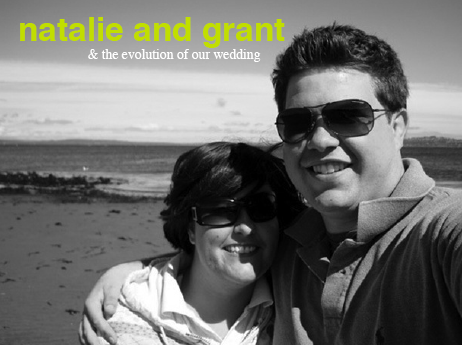
Saturday, February 21, 2009
Thursday, February 19, 2009
"THE DESTINATION WEDDING" By Lois Smith Brady, New York Times Reporter
A lot of people resent "destination weddings," which have become increasingly popular—among brides and grooms, anyway. These far-flung events require guests to travel to an uninhabited island off the coast of Maine, a castle in Portugal, or a mosque in Turkey. One might have to take multiple airplanes to get there, or navigate roads with potholes as deep as bathtubs, or stay in a hotel with no outgoing lines. In some people, this creates wedding rage.
Even the smallest amount of traveling can unnerve wedding guests. I once attended a wedding that required everyone to walk for miles, literally. It took place in Manhattan and was called the Seven-Stop Wedding. The couple led their guests to seven of their most sentimental spots. We visited the park where they first kissed. We climbed stairs to the rooftop of an art museum.
I don't recall the significance of the rooftop (the proposal, maybe?), but I do remember everyone huffing and puffing when they got there. The experience was like boot camp. But I remember it more clearly than the 50 other ceremonies I attended as a wedding reporter that year. The walking added much more camaraderie than you'll ever feel at a church wedding. It was a calorie-burner, and you can't say that about many parties.
A conventional wedding is the opposite: it always seems like an uninspired beginning, like a very long, uninteresting first sentence to a novel. Generally, it is full of rhetorical language and other things that put you to sleep. You certainly don't feel sleepy or bored as a wedding guest standing barefoot on a beach on Maui—even if your flight in was delayed.
Traveling is an apt metaphor for love. Both can be risky and both give you a heightened sense of all the things that can go terribly wrong. You can lose your luggage or get on the plane heading to Reno instead of Rio. Your heart can be broken, badly. These days, walking down the aisle means taking a fifty-fifty chance. Why not bring your guests to a place where the chance of their luggage being lost is also fifty-fifty, as is the chance of having Internet service, or even room service?
Once, I flew into Buffalo, New York, to watch a couple say their vows next to Niagara Falls. The bride and groom could easily have had a similar five-minute, inaudible civil ceremony at city hall. But it was worth traveling for the background roar and the symbolism. Another time, I went to a wedding in Utah where every guest stayed at the same slopeside hotel, which soon took on a dormitory atmosphere. Most guests had never been to Snowbird before; many didn't ski. But the unfamiliar "Where am I?" feeling seemed perfect. No matter how much you read about marriage, no matter how much you quiz your parents or your therapists, as a bride and groom you will always walk down the aisle into your own uniquely unknown territory.
And when someone can take you elsewhere, that is love. It's a form of unintentional, unplanned traveling. As John Steinbeck said, the best kinds of journeys are not the ones you take. The best are the ones that take you.
Even the smallest amount of traveling can unnerve wedding guests. I once attended a wedding that required everyone to walk for miles, literally. It took place in Manhattan and was called the Seven-Stop Wedding. The couple led their guests to seven of their most sentimental spots. We visited the park where they first kissed. We climbed stairs to the rooftop of an art museum.
I don't recall the significance of the rooftop (the proposal, maybe?), but I do remember everyone huffing and puffing when they got there. The experience was like boot camp. But I remember it more clearly than the 50 other ceremonies I attended as a wedding reporter that year. The walking added much more camaraderie than you'll ever feel at a church wedding. It was a calorie-burner, and you can't say that about many parties.
A conventional wedding is the opposite: it always seems like an uninspired beginning, like a very long, uninteresting first sentence to a novel. Generally, it is full of rhetorical language and other things that put you to sleep. You certainly don't feel sleepy or bored as a wedding guest standing barefoot on a beach on Maui—even if your flight in was delayed.
Traveling is an apt metaphor for love. Both can be risky and both give you a heightened sense of all the things that can go terribly wrong. You can lose your luggage or get on the plane heading to Reno instead of Rio. Your heart can be broken, badly. These days, walking down the aisle means taking a fifty-fifty chance. Why not bring your guests to a place where the chance of their luggage being lost is also fifty-fifty, as is the chance of having Internet service, or even room service?
Once, I flew into Buffalo, New York, to watch a couple say their vows next to Niagara Falls. The bride and groom could easily have had a similar five-minute, inaudible civil ceremony at city hall. But it was worth traveling for the background roar and the symbolism. Another time, I went to a wedding in Utah where every guest stayed at the same slopeside hotel, which soon took on a dormitory atmosphere. Most guests had never been to Snowbird before; many didn't ski. But the unfamiliar "Where am I?" feeling seemed perfect. No matter how much you read about marriage, no matter how much you quiz your parents or your therapists, as a bride and groom you will always walk down the aisle into your own uniquely unknown territory.
And when someone can take you elsewhere, that is love. It's a form of unintentional, unplanned traveling. As John Steinbeck said, the best kinds of journeys are not the ones you take. The best are the ones that take you.
Saturday, February 14, 2009
Photographer I Love

Her name is Jasmine Star; you can see her work here: http://www.jasmine-star.com/#/home/
I really love this shoot of hers: http://www.jasmine-star.com/#/carissa---brian---wedding/ And the song playing!
Friday, February 13, 2009
Colors

Mostly the same as before. Some of the colors from before didn't seem happy enough/took themselves too seriously. And you know we don't take things too seriously, so we looked (I looked, Grant nodded) at colors that made us happy and decided on a simple palette of orange, navy, and electric purple. Click on the image for a larger view of the mood board.
Friday, February 6, 2009
My something new (although it will probably be my something old by november 2010)
Wednesday, February 4, 2009
Started Making a Mood Board

for color ideas. This is one thing I want to solidify before we send out the save-the-dates so that everything is cohesive. Grant (surprising) liked the peacock feather. Even more than the flower veil. I'm thinking rich blues, greens, and purples, with olivey-gold accents. I'd also like to incorporate faux bois texture and have the BMs carry peacock feather fans instead of bouquets. Click on the picture for a bigger view.
Tuesday, February 3, 2009
Good Thing We're Not Getting Married til 2010

Because I have plenty of time to change my mind on things. I've recently been addicted to a website: www.etsy.com. Looove it. They have the neatest stuff on there and it's all handmade and custom, which I love.
I recently stumbled upon this headpiece that I am kind of really into at the moment. I think I'd have to angle it back though so that brightest feather was more tilted backwards than straight up. It's a little out there, but I liked it so much that now I'm reconsidering the whole orange, coral, pink idea and thinking of going with colors of a peacock. Maybe when I send out my invitations to be a bridesmaid I'll just include a peacock feather and say "please match the dress of your choosing to one of the colors in this feather." That's more my style, and it might look super freaking awesome against the Pacific water. Tell me what you think about the headpiece. (Instead of a veil, or with a birdcage veil like the one in the picture below.) I might change my mind next week, but then again, I might not.
Subscribe to:
Comments (Atom)





